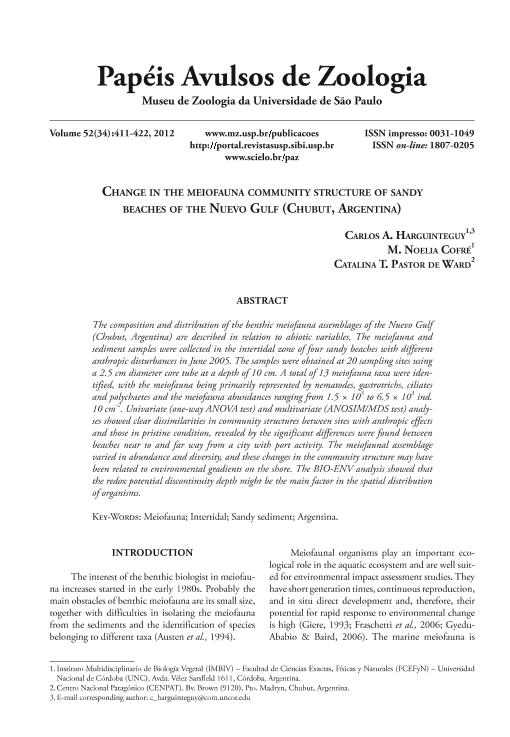Artículo
The composition and distribution of the benthic meiofauna assemblages of the Nuevo Gulf (Chubut, Argentina) are described in relation to abiotic variables. The meiofauna and sediment samples were collected in the intertidal zone of four sandy beaches with different anthropic disturbances in June 2005. The samples were obtained at 20 sampling sites using a 2.5 cm diameter core tube at a depth of 10 cm. A total of 13 meiofauna taxa were identified, with the meiofauna being primarily represented by nematodes, gastrotrichs, ciliates and polychaetes and the meiofauna abundances ranging from 1.5 × 103 to 6.5 × 103 ind. 10 cm-2. Univariate (one-way ANOVA test) and multivariate (ANOSIM/MDS test) analyses showed clear dissimilarities in community structures between sites with anthropic effects and those in pristine condition, revealed by the significant differences were found between beaches near to and far away from a city with port activity. The meiofaunal assemblage varied in abundance and diversity, and these changes in the community structure may have been related to environmental gradients on the shore. The BIO-ENV analysis showed that the redox potential discontinuity depth might be the main factor in the spatial distribution of organisms. La composición y distribución de la meiofauna bentónica del Golfo Nuevo (Chubut, Argentina) se describen en relación a las variables ambientales. La meiofauna y el sedimento de la zona intermareal de cuatro playas de arena con diferentes perturbaciones antrópicas fueron recolectadas en Junio de 2005. Las muestras se colectaron en 20 sitios de muestreo con tubos core de 2,5 cm de diámetro y 10 cm de profundidad. Fueron identificados 13 taxones de meiofauna, representados principalmente por nematodos, gastrotricos, ciliados y poliquetos y la abundancia de la meiofauna que fue desde 1,5 × 103 a 6,5 × 103 ind. 10 cm‑2. Los análisis univariado (ANOVA de una-vía) y multivariado (ANOSIM/MDS) indicaron diferencias significativas en las estructuras de la comunidad entre los sitios con efectos antrópicos y aquellos en condiciones prístinas, revelando que estas diferencias fueron entre las playas próximas y alejadas de una ciudad con la actividad portuaria. Los cambios en la estructura de la comunidad (abundancia y diversidad) pueden haber estado relacionados con gradientes ambientales próximos a la costa. El análisis BIO‑ENV mostró que la profundidad de la discontinuidad del potencial redox puede ser el principal factor que influye en la distribución espacial de los organismos.
Change in the meiofauna community structure of sandy beaches of the nuevo gulf (Chubut, Argentina)
Fecha de publicación:
12/2012
Editorial:
Universidade de São Paulo. Museu de Zoologia
Revista:
Papéis Avulsos de Zoologia
ISSN:
0031-1049
e-ISSN:
1807-0205
Idioma:
Inglés
Tipo de recurso:
Artículo publicado
Clasificación temática:
Resumen
Palabras clave:
Meiofauna
,
Intertidal
,
Sandy Sediment
,
Argentina
Archivos asociados
Licencia
Identificadores
Colecciones
Articulos(IMBIV)
Articulos de INST.MULTIDISCIPL.DE BIOLOGIA VEGETAL (P)
Articulos de INST.MULTIDISCIPL.DE BIOLOGIA VEGETAL (P)
Citación
Harguinteguy, Carlos Alfredo; Cofré, María Noelia; Pastor, Catalina Teresa; Change in the meiofauna community structure of sandy beaches of the nuevo gulf (Chubut, Argentina); Universidade de São Paulo. Museu de Zoologia; Papéis Avulsos de Zoologia; 52; 34; 12-2012; 411-422
Compartir




